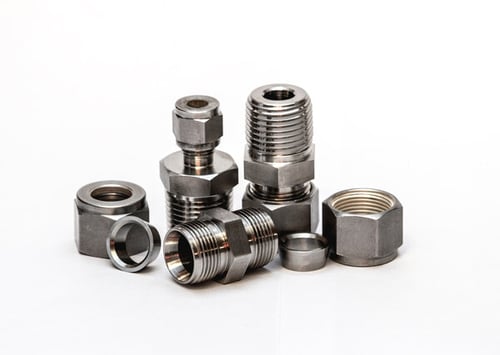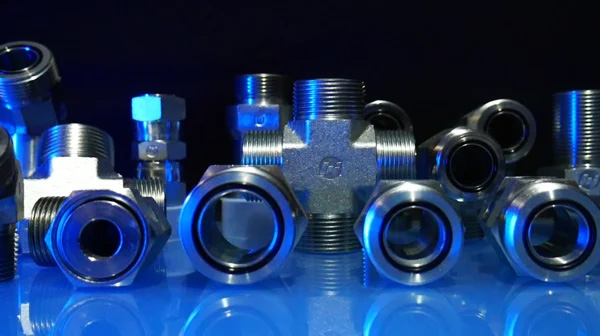A boss fitting walks into a bar and the bartender says, "I'm sorry, we don't serve boss fittings in here." The irate fitting angrily says, "Why not?" and the bartender says, “Because you’re too well connected.”
 There are a wide variety of tube fittings used for an untold number of applications. We'll be focusing on the most widely used and their benefits for this blog. There are two primary categories: instrumentation tube fittings and industrial tube fittings.
There are a wide variety of tube fittings used for an untold number of applications. We'll be focusing on the most widely used and their benefits for this blog. There are two primary categories: instrumentation tube fittings and industrial tube fittings.
- Instrumentation compression tube fittings are most often used in process instrumentation, analytical applications and are categorized as:
- Single ferrule compression tube fittings for many demanding applications in a variety of manufacturing industries, such as chemical, petroleum, power generating and pulp and paper. These fittings are highly reliable and virtually leak-proof. Single ferrule tube fittings can be found in instrumentation and process and control systems where high-quality fittings are required.
- Double ferrule compression tube fittings are the most common instrumentation style fittings and are ideal for process measurement and control systems in industries such as oil & gas, defense, chemical processing plants, aerospace and medical equipment. Double ferrules provide a much stronger, leak-safe seal, allowing for better vibration resistance than single ferrule fittings. They are exceptionally safe and reliable for high-pressure applications, performing equally well on thick and thinner walled tubing. However, the additional back ferrule makes them a little more tedious to assemble correctly, despite offering a higher level of performance.
Both single and double ferrule tube fittings are available in stainless steel or brass materials.

- Industrial tube fittings are typically made of stainless or carbon steel and used for applications in a wide range of industries including fluid power, petrochemical, chemical, aerospace, defense, marine and automotive. The most common industrial tube fittings are classified as:
- SAE 37° Flare fittings are used in extreme applications that are subject to high pressure, thermal shock and vibration. The unique design of flare fittings ensures the tube sleeve is in alignment with the fitting, reducing strain on the tube. These fittings are well suited for disassembly and re-assembly during maintenance, without the need to replace any components.
- SAE Flareless bite type fittings are commonly used in high-vibration systems where it is impractical or unnecessary to flare the tubing. SAE flareless fittings bow during assembly and ‘bite into' the tubing wall. The spring-action joint provides exceptional shock absorption and holding power. However, unlike 37° flare fittings, they are limited to how many times they can be disassembled and reassembled as the ferrule bites deeper into the tube wall each time.
- O-ring face seal fittings have a high resistance to leaks. They are often used in turbine controls, liquid fuel control systems and other applications that require a leak-tight seal. They are commonly utilized in chemical plants, general industrial equipment, hydraulic fracturing operations, off-road construction and agricultural equipment. ORFS fittings are often the best choice for applications that experience frequent vibration and actuation of components.
Material
Stainless steel fittings are extremely tough and resistant to chemical exposure and corrosion. Stainless fittings can withstand extreme temperatures ranging from -425° to 1200°F (-254° to 649°C). They are best suited for high-pressure applications and when the fluid or environment is corrosive.
Most industrial stainless steel fittings have a rating of 10,000 PSI. They can also be specially designed for extremely high-pressure applications of up to 20,000 PSI.
Carbon steel fittings have an allowable pressure rating of up to 18,000 PSI. However, they are not suitable for high-corrosion environments or low temperatures due to ratings of only -65° to 500°F (-54° to 260°C). Carbon steel fittings are used extensively in construction, agriculture and industrial equipment due to their strength, high-pressure capabilities and relatively low cost.
Brass fittings are a popular choice, made from reasonably strong material, with good corrosion resistance and ductility at low temperatures ranging from -325° to 400° F (-198° to 204° C). Most brass fittings are rated for lower pressures depending on their design—however, if their size and the specific application are suitable, they can withstand pressures of up to 3,000 PSI.
Other widely used classifications include NPT fittings, O-Ring Boss fittings, JIC fittings, Cone and Thread fittings, Weld fittings, along with associated caps, plugs and nuts.
Since you seemed interested in our instrumentation content, check our free BluePrint as a helpful resource:
Sources Include:

